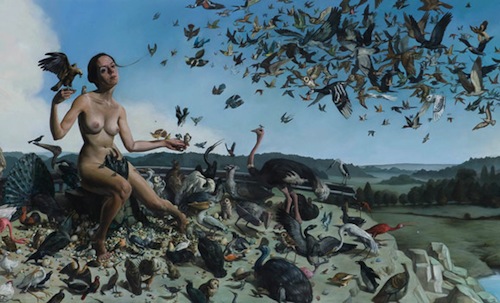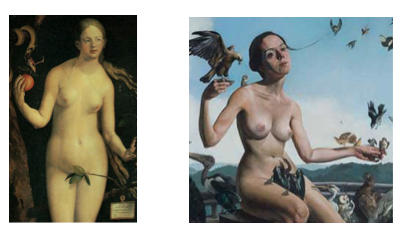Any curated show imposes various meanings – or elicits particular associations, or crafts a range of contexts: choose your wording – upon the involved works of art. But the BMA’s current “Surreal Selves” show feels particularly eclectic in its efforts to frame the paintings on display. After all, the very title of the show nudges us to think of the paintings in terms of surreal content or tone, even as it also foregrounds their consistently figurative aspect. Kristen Hileman’s accompanying text, meanwhile, stresses the relative youth of the three artists, and the – well, the fact that the paintings are painted. “Given the capacity of today’s digital technology,” writes Hileman, “to generate virtual worlds and fantastical avatars, it is remarkable that young artists turn to painting to produce new permutations of the human body.” Before we even consider the individual paintings, then, we are primed to think in terms of materiality, and authorship, and subject matter, and style.
Intriguingly, though, at least one of the works in the show – Erik Thor Sandberg’s Receptivity (2011) – insists on defining itself in its own diverse terms, in ways that complicate the museum’s efforts at framing. Indeed, Hileman seems to realize this; in the accompanying text, she notes how some of Sandberg’s works seem to allude to the panoramic allegories of Old Masters such as Bosch, Cranach the Elder, and Poussin. That’s a diverse cast, and the diversity is important: they suggest that Sandberg’s paintings can’t be rhetorically contained very concisely. They are not merely surreal (although they are that: the unexplained nudity of the female figure and the sheer impossibility of the intermingled bird species, for instance, combine to form an evocative sense of reverie, even as they also illustrate the essential mechanism of the dreamwork that Freud termed condensation). And they are not merely figural (although of course they are that, too). They are, we might say, art historically promiscuous.
In this short essay, then, I want to trace yet another way of reading Receptivity, by thinking about some of its art historical references or affinities. Specifically, I want to read it in relation to Renaissance and Mannerist images of creation, and paradise, and falls from paradise. I’m thinking, for instance, of a 1628 painting by Roelandt Savery, who worked for a time in Prague, for Rudolf II. His Landscape with Birds is one of several works painted at about the same time that populate an ambitious landscape with an improbable combination of bird species – and that thus anticipates Sandberg’s comparable love of natural observation, abundance and odd juxtaposition.
Both works might be said to reflect, in fact, a late Renaissance fondness for systematized nature: for zoological and biological encyclopediae, for Wunderkammern and Kunstkammern (one of which was, incidentally, was assembled by Rudolf II), or for natural history cabinets. At the same time, both paintings might also be called Edenic, in their dense natural abundance and apparent interest in sheer fecundity. Indeed, art historians have long noted that Savery’s landscapes seem to be based on earlier paintings of paradise. And that latent association, I would suggest, also extends to Sandberg’s work. We are urged, through Sandberg’s quiet allusion to Savery, to think in terms of paradise.
But also, perhaps, of paradise lost – for both paintings include, as well, references to apparent ruins. In the upper left corner of Savery’s painting, a derelict tower looms. We see its decayed state, and we intuit loss. And then we spot a similar detail in Receptivity: a highway guardrail, oddly abbreviated and seemingly without clear purpose. The road that it once accompanied is not visible; the works of man are abandoned and without clear relevance in a world overrun by animals. Engineering gives way to wilderness, order to entropy.
Importantly, though, Sandberg’s work is not unpeopled. Unlike Savery, he offers a protagonist: the young woman, who seems to commune with the birds that flock towards her. But here, too, I think that Sandberg relies upon subtle art historical references in order to further our sense of a tension between paradise and paradise lost. Note, for instance, that the central group of Receptivity evokes, in very basic formal terms, the most famous of all Cinquecento images of Creation:
The subjects, no doubt, are radically different: Adam gives way to a woman, and God’s host to a flock of diverse birds. But, still: in each image a dense cloud of forms in the upper right extends towards a nude human, and the motion culminates in a potent, focused contact between spheres. The languid gazes and lolling heads of the figures also correspond; so, too, does the essentially receptive aspect of the human subject. (In his book Art and Visual Perception, Rudolf Arnheim wrote that “The abstract core of Michelangelo’s Creation of Adam is… the interplay of an active and a receptive principle.” Sandberg, then, is merely blunter in simply titling his work Receptivity). Such rough correspondences nudge us to read, again, Sandberg’s painting in a particular way: in terms of animation, or creation – or, better still, genesis. And once we begin to think in terms of genesis, we also begin to think in terms of Genesis – we are, again, associatively in Eden.
If we are in Eden, though, then our time is already limited. And here, once more, Sandberg’s painting reminds us of the imminent fall and expulsion. Consider, for instance, Dürer’s famous Eve of 1507. If we flip her figure, we suddenly see a young woman whose pose roughly anticipates that of Sandberg’s protagonist, in gesture if not in precise tone or dimensions:
Both look vaguely to the left, and extend their left hands. More importantly, both are nude, their genitals only concealed by improbable forms (a sprig; a long-necked bird). In turn, our awareness of this nudity (an awareness heightened in Sandberg’s painting by the woman’s stark tan lines) already points to a post-lapsarian self-consciousness. We have already, apparently, bitten of the apple. And so it’s no surprise to find that the right hands of both figures are approached by active, ominous animals: the serpent, in Dürer’s painting, and a bird of prey, in Sandberg’s. Sin, or the fall, seems to be quietly written into each image.
So: loose compositional matches spread out before us, we wonder what to think. Sandberg’s intelligent, restrained invocation of Renaissance and Mannerist images of paradise and paradise lost seems to prompt us to think in certain terms. But why, we might ask, these 16th- and 17th-century allusions? Why that period, in particular? I suppose that the affinity might be irreducibly personal, a matter of private taste on the part of the painter. Certainly, Sandberg seems interested in Mannerism: think of his use of a curved ground (an approach used by Parmigianino and El Greco, as well), and his tendency towards excess and narrative illogic (all of these birds, in one space? really?). But in fact Sandberg’s allusions to Mannerist tropes and precedents seem especially pointed, given Receptivity’s apparent interest in fall, or collapse. After all, art historians have long wondered if the popularization of Mannerism might have been related to the fall and sack of Rome in the 1520s. Perhaps, perhaps not: in any case, it’s clear that Rome, at the height of Italian Mannerism, was a tense city across which flitted eschatological ideas. In 1527, the dam broke: the city fell to imperial troops, yielding a sense of crisis and disarray, and a diaspora, as artists and residents fled Rome. And as they fled – like Adam and Eve, cast out – they carried the style to foreign capitals, such as Rudolf’s Prague. Savery’s work, in short, was partly informed by the sort of calamity that seems to have visited the tower that sprouts weeds in its upper left.
And this, this, is why Sandberg’s gestures towards Mannerism seem especially productive. Repeatedly, his work has been discussed in terms of an ambiguous or unsettled view of the fraught relationship between humankind and nature. Materials accompanying a 2011 show of his work, for instance, claimed that he “unleashes allegories of our increasingly complex relationship with nature,” while Hileman writes that in his works “one might recognize a pessimistic view of the present-day search for self-realization and spirituality through connections with the natural world.” Yes, and yes. But in looking patiently at Receptivity and its knowing use of art historical precedents, we can learn more about how Sandberg generates such effects. The world may seem – to us; to Adam; to Eve; to a contemporary painter – a given. But in trying to prove receptive to it, we often distance ourselves from it: we take the apple; we study the painting instead of the world. Or we defile it: think of the vast oil slick that washed across the Gulf of Mexico as Sandberg began his painting. Receptivity to the world can imply an open awareness of its raw possibilities, or an acceptance of the divine spark, or an embrace of artistic precedents. But it also implies, simultaneously, the billowing oil well, the apple accepted, the slick surface of Mannerism. Like Rome, our world is both eternal, and subject to collapse. Receptivity may stand at the beginning of it all. But receptivity can also lead to a fall.
Surreal Selves will be on view at the BMA’s Front Room Gallery through June 9, 2013.
Author Kerr Houston teaches art history and art criticism at MICA; he is also the author of An Introduction to Art Criticism (Pearson, 2013) and recent essays on Wafaa Bilal, Emily Jacir, and Candice Breitz.







